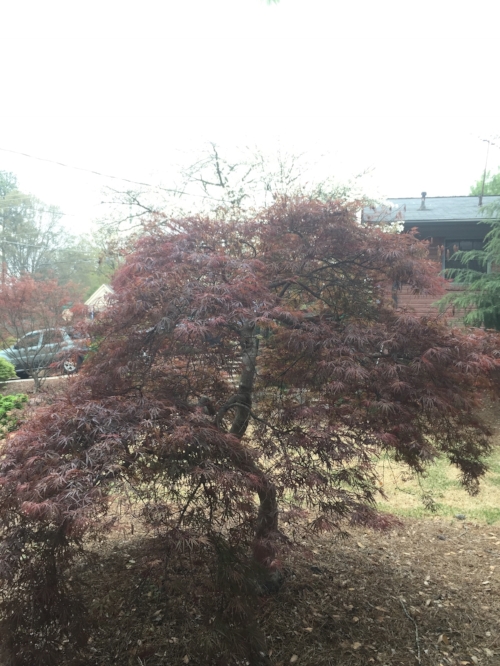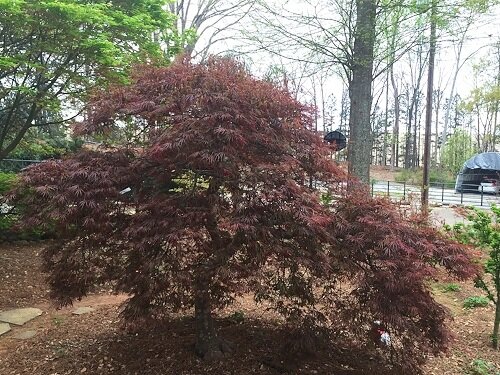
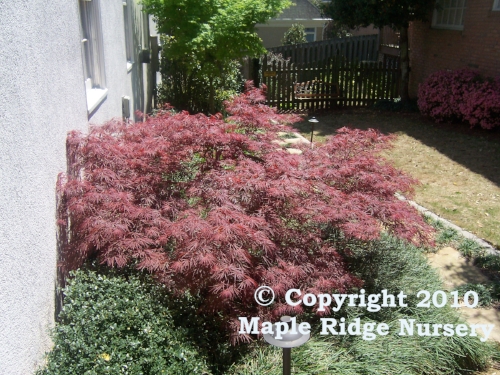
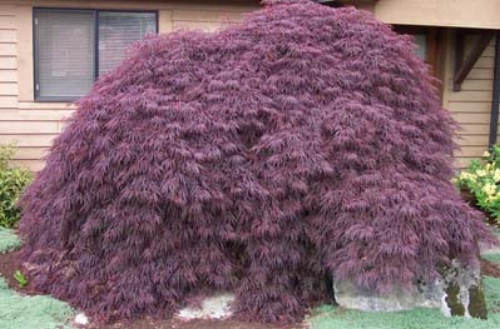
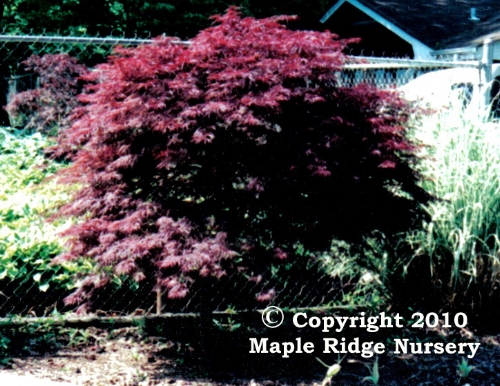
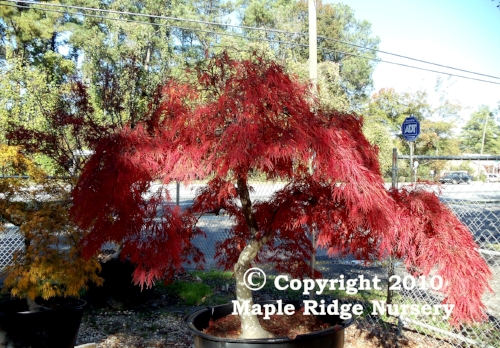
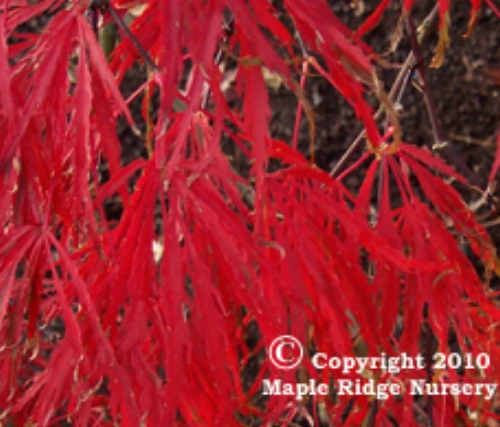
Description:
Acer palmatum ‘Crimson Queen’ is known for its brilliant color and graceful shape. Named for its crimson spring color, this tree emerges as one of the most gorgeous Japanese Maples in early spring. In cooler climates, the crimson, red leaves will remain through most of the summer. However, in the South these leaves will turn green by July and develop a bronze hue if planted in full sun. The spring color can be kept longer into the summer in hotter climates if this tree is provided afternoon shade. Regardless of the summer color, ‘Crimson Queen’ performs one last show as the leaves turn bright red in the fall.
As this tree ages, the branching structure takes on almost as big a role as the leaves, making ‘Crimson Queen’ beautiful even in the winter. If left alone, ‘Crimson Queen’ becomes a flowy, shrub-like tree that can wonderfully fill out a space in the garden. However, with quality pruning it can become a work of art and a real show stopper.
It is a dwarf tree that can be used in nearly every landscape. In most situations ‘Crimson Queen’ can be expected to grow between 4 and 6 feet tall and about 6 to 8 feet wide in 10 years.
Another wonderful characteristic of ‘Crimson Queen’ is its propensity to handle full sun in even the hottest climates. It would prefer to be protected from the direct afternoon sun in order to deliver the best color, but it’s tough enough to handle the heat.
10 year size:
Height: 4-6 Feet Width 6-8 Feet
Acer palmatum ‘Crimson Queen’ grows similarly in size and shape to most other dissectum Japanese maples. Low grafted Crimson Queen trees when left alone may top out at 3 or four feet while other Crimson Queens can be trained to reach 8 to 10 feet tall. The natural habit of a Crimson Queen Japanese maple is going to create a weeping Japanese maple that is roughly 4 to 6 feet tall in 10 years.
The width of Crimson Queen will naturally expand to about 6 or 8 feet wide in ten years without any intervention. However, Crimson Queen can be easily trained by pruning to maintain a smaller width.
Colors:
The peak colors of Crimson Queen are almost unmatched among other dissectum Japanese maples. Acer palmatum ‘Crimson Queen’ emerges in spring with bright, crimson colored leaves. In cooler climates, the crimson, red leaves will remain through most of the summer. However, in the South and other hotter areas these leaves will turn green by July and develop an attractive bronze hue. The spring color can be kept longer into the summer in hotter climates if this tree is provided afternoon shade. Regardless of the summer color, ‘Crimson Queen’ performs one last show as the leaves turn bright, scarlet red in the fall.
Structure:
Acer palmatum ‘Crimson Queen’ has a typical habit for a dissectum Japanese maple. Crimson Queen grows with a weeping, cascading, or spreading habit. When a Crimson Queen is kept low, the structure of this Japanese maple tree will be low and spreading across the ground. If trained or allowed to achieve a little more height, Crimson Queen will be a Japanese maple tree with more of a cascading habit with gentle weeping branches. Acer palmatum ‘Crimson Queen’ has one of the more beautiful and elegant weeping habits of all the dissectum Japanese maples.
History:
Acer palmatum ‘Crimson Queen’ is one of the very most popular Japanese Maples in the world and is often the first tree people think of when they think of Japanese Maples. Introduced back in the 1960s, ‘Crimson Queen’ has become the gold standard by which all other lace leaf Japanese Maples are judged. The name says it all as this tree is undoubtedly royalty in the gardening world, winning the Royal Horticultural Society’s Award of Garden Merit in 1993.
Hardiness:
USDA Plant Hardiness Zones: 5-9
AHS Heat Zone: 5-10
Sunset Climate Zone: 3-10, 12, 14-24, 28-37
Japanese maples such as Acer palmatum ‘Crimson Queen’ are hardy in most regions of the United States. The only areas where they will not work are areas of extreme cold or extreme hot temperatures. Areas of extremely high altitudes may also not work particularly well for Japanese maples. Japanese maples will also thrive better in areas of consistent rainfall. These zones are general rules, but exceptions do apply. Do your own research on your particular area before purchasing a Japanese maple, but Japanese maples are generally a very hardy tree.
Sun Tolerance:
The majority of Japanese maples are going to prefer some variation of morning sun and afternoon shade. While this is great in a perfect world, it is not realistic for every Japanese maple. Many Japanese maples can handle much more sun, such as Acer palmatum ‘Crimson Queen’ Crimson Queen can handle up to all day sun with little issues. However, better color will be maintained in the summer if given a break from the hot afternoon sun.
Planting:
Planting a Japanese Maple in the Ground:
All Japanese maples should be planted slightly elevated on a mound. This can be done by leaving a small portion of the rootball above ground level when planting. Dirt is then brought up to the sides covering up the majority of the roots. The end result is an elevated mound up to the base of the tree. The root flare where the trunk ends and the roots begin should be visible above ground level when planting is finished. A light layer of pine straw or pine bark mulch around the tree is all the mulch that is needed for a Japanese maple. Don’t pile too much mulch up against the trunk of the tree.
Planting a Japanese maple in a Container:
Japanese maples like Crimson Queen work great as container plants. When planting a Japanese maple in a container, we typically recommend a 50/50 mix of soil conditioner and potting soil. This will provide a good growing medium for your tree while also allowing for proper drainage. You still want to plant your Japanese maple slightly elevated in the container with the root flare above the dirt level.
Soil Requirements:
Japanese maples like Acer palmatum ‘Crimson Queen’ prefer slightly acidic soils, but they are very adaptable to nearly any soil. We rarely recommend any soil amendments when planting a new Japanese maple other than possibly some soil conditioner or top soil to fill in here and there. The main thing to consider with soil is the drainage. Japanese maples love well draining soil. They like to get wet, but they don’t like to stay wet. This is another reason that we recommend planting Japanese maples elevated on a mound, so that the water can drain out from the roots of the Japanese maple tree.
Watering:
Japanese maples like moist well draining conditions. They like good soakings, but then that water needs a chance to drain away. Japanese maples do not like wet feet. When you first plant your Crimson Queen, you should water no more than once or twice per week depending on the time of the year. Your Crimson Queen Japanese maple may need more water when planted in the summer versus if it is planted in the fall or winter. After a couple of months you can back off on the watering a little bit as the tree is getting established. There is no need to water your Crimson Queen while it is dormant unless there is no rain for several weeks. Your Crimson Queen should be able to live off of nothing but rain water after the first year in the ground. You can give it a drink again if there hasn’t been any rain for a couple weeks or so. Important: most people have more issues overwatering their Japanese maple than under watering it. Don’t kill your Japanese maple tree with kindness.
Special Care:
There is very little special care required with Japanese maples, including Acer palmatum ‘Crimson Queen’ You want to fertilize your Japanese maple in the spring with an organic Japanese maple fertilizer such as Happy Frog. This will ensure that your Crimson Queen Japanese maple is receiving all the nutrients it needs to flourish in your yard.
Pruning:
You can prune your Crimson Queen Japanese maple in the winter when the tree is dormant. This is the best time to prune a Japanese maple because the energy of the tree is not flowing as actively as it may in the spring or summer. Crimson Queen takes very well to pruning and can become an elegant tree over time with proper care. There are many different ways to prune a Japanese maple. As long as you only prune in the winter and never take more than a third of the tree off at any given time, then it is hard to go wrong. Pruning is all about your personal preferences and making your tree look good for you.

